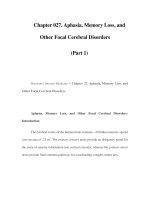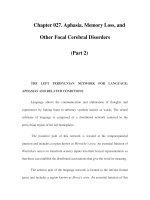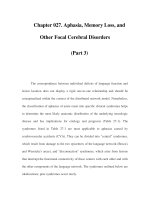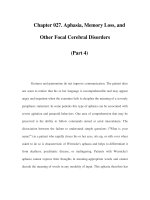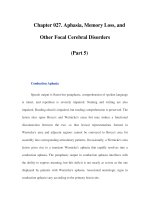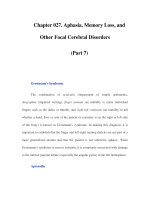Chapter 9 net present value and other investment criteria
Bạn đang xem bản rút gọn của tài liệu. Xem và tải ngay bản đầy đủ của tài liệu tại đây (273.63 KB, 50 trang )
Chapter 9
Net Present Value and
Other Investment
Criteria
McGraw-Hill/Irwin
Copyright © 2010 by The McGraw-Hill Companies, Inc. All rights reserved.
Key Concepts and Skills
•
Be able to compute payback and discounted
payback and understand their shortcomings
•
Understand accounting rates of return and
their shortcomings
•
Be able to compute internal rates of return
(standard and modified) and understand their
strengths and weaknesses
•
Be able to compute the net present value and
understand why it is the best decision
criterion
•
Be able to compute the profitability index and
understand its relation to net present value
9-2
Chapter Outline
•
Net Present Value
•
The Payback Rule
•
The Discounted Payback
•
The Average Accounting Return
•
The Internal Rate of Return
•
The Profitability Index
•
The Practice of Capital Budgeting
9-3
Good Decision Criteria
•
We need to ask ourselves the
following questions when evaluating
capital budgeting decision rules:
–
Does the decision rule adjust for the
time value of money?
–
Does the decision rule adjust for risk?
–
Does the decision rule provide
information on whether we are creating
value for the firm?
9-4
Net Present Value
•
The difference between the market value
of a project and its cost
•
How much value is created from
undertaking an investment?
–
The first step is to estimate the expected
future cash flows.
–
The second step is to estimate the required
return for projects of this risk level.
–
The third step is to find the present value of
the cash flows and subtract the initial
investment.
9-5
Project Example Information
•
You are reviewing a new project and have
estimated the following cash flows:
–
Year 0: CF = -165,000
–
Year 1: CF = 63,120; NI = 13,620
–
Year 2: CF = 70,800; NI = 3,300
–
Year 3: CF = 91,080; NI = 29,100
–
Average Book Value = 72,000
•
Your required return for assets of this risk
level is 12%.
9-6
NPV – Decision Rule
•
If the NPV is positive, accept the
project
•
A positive NPV means that the project is
expected to add value to the firm and will
therefore increase the wealth of the
owners.
•
Since our goal is to increase owner
wealth, NPV is a direct measure of how
well this project will meet our goal.
9-7
Computing NPV for the
Project
•
Using the formulas:
–
NPV = -165,000 + 63,120/(1.12) + 70,800/
(1.12)
2
+ 91,080/(1.12)
3
= 12,627.41
•
Using the calculator:
–
CF
0
= -165,000; C01 = 63,120; F01 = 1; C02 =
70,800; F02 = 1; C03 = 91,080; F03 = 1; NPV;
I = 12; CPT NPV = 12,627.41
•
Do we accept or reject the project?
9-8
Decision Criteria Test - NPV
•
Does the NPV rule account for the time
value of money?
•
Does the NPV rule account for the risk of
the cash flows?
•
Does the NPV rule provide an indication
about the increase in value?
•
Should we consider the NPV rule for our
primary decision rule?
9-9
Calculating NPVs with a
Spreadsheet
•
Spreadsheets are an excellent way to
compute NPVs, especially when you have to
compute the cash flows as well.
•
Using the NPV function
–
The first component is the required return
entered as a decimal
–
The second component is the range of cash
flows beginning with year 1
–
Subtract the initial investment after computing the
NPV
9-10
Payback Period
•
How long does it take to get the initial cost
back in a nominal sense?
•
Computation
–
Estimate the cash flows
–
Subtract the future cash flows from the initial
cost until the initial investment has been
recovered
•
Decision Rule – Accept if the payback
period is less than some preset limit
9-11
Computing Payback for the
Project
•
Assume we will accept the project if it pays
back within two years.
–
Year 1: 165,000 – 63,120 = 101,880 still to
recover
–
Year 2: 101,880 – 70,800 = 31,080 still to
recover
–
Year 3: 31,080 – 91,080 = -60,000 project
pays back in year 3
•
Do we accept or reject the project?
9-12
Decision Criteria Test -
Payback
•
Does the payback rule account for the
time value of money?
•
Does the payback rule account for the risk
of the cash flows?
•
Does the payback rule provide an
indication about the increase in value?
•
Should we consider the payback rule for
our primary decision rule?
9-13
Advantages and
Disadvantages of Payback
•
Advantages
–
Easy to understand
–
Adjusts for
uncertainty of later
cash flows
–
Biased toward
liquidity
•
Disadvantages
–
Ignores the time
value of money
–
Requires an
arbitrary cutoff point
–
Ignores cash flows
beyond the cutoff
date
–
Biased against
long-term projects,
such as research
and development,
and new projects
9-14
Discounted Payback Period
•
Compute the present value of each cash
flow and then determine how long it takes
to pay back on a discounted basis
•
Compare to a specified required period
•
Decision Rule - Accept the project if it
pays back on a discounted basis within
the specified time
9-15
Computing Discounted Payback
for the Project
•
Assume we will accept the project if it pays back
on a discounted basis in 2 years.
•
Compute the PV for each cash flow and
determine the payback period using discounted
cash flows
–
Year 1: 165,000 – 63,120/1.12
1
= 108,643
–
Year 2: 108,643 – 70,800/1.12
2
= 52,202
–
Year 3: 52,202 – 91,080/1.12
3
= -12,627 project pays
back in year 3
•
Do we accept or reject the project?
9-16
Decision Criteria Test –
Discounted Payback
•
Does the discounted payback rule account for the
time value of money?
•
Does the discounted payback rule account for the
risk of the cash flows?
•
Does the discounted payback rule provide an
indication about the increase in value?
•
Should we consider the discounted payback rule
for our primary decision rule?
9-17
Advantages and Disadvantages
of Discounted Payback
•
Advantages
–
Includes time value
of money
–
Easy to understand
–
Does not accept
negative estimated
NPV investments
when all future
cash flows are
positive
–
Biased towards
liquidity
•
Disadvantages
–
May reject positive
NPV investments
–
Requires an
arbitrary cutoff
point
–
Ignores cash flows
beyond the cutoff
point
–
Biased against
long-term projects,
such as R&D and
new products
9-18
Average Accounting Return
•
There are many different definitions for
average accounting return
•
The one used in the book is:
–
Average net income / average book value
–
Note that the average book value depends on
how the asset is depreciated.
•
Need to have a target cutoff rate
•
Decision Rule: Accept the project if the
AAR is greater than a preset rate
9-19
Computing AAR for the
Project
•
Assume we require an average
accounting return of 25%
•
Average Net Income:
–
(13,620 + 3,300 + 29,100) / 3 = 15,340
•
AAR = 15,340 / 72,000 = .213 =
21.3%
•
Do we accept or reject the
project?
9-20
Decision Criteria Test - AAR
•
Does the AAR rule account for the time
value of money?
•
Does the AAR rule account for the risk of
the cash flows?
•
Does the AAR rule provide an indication
about the increase in value?
•
Should we consider the AAR rule for our
primary decision rule?
9-21
Advantages and
Disadvantages of AAR
•
Advantages
–
Easy to calculate
–
Needed
information will
usually be
available
•
Disadvantages
–
Not a true rate of
return; time value
of money is
ignored
–
Uses an arbitrary
benchmark cutoff
rate
–
Based on
accounting net
income and book
values, not cash
flows and market
values
9-22
Internal Rate of Return
•
This is the most important alternative
to NPV
•
It is often used in practice and is
intuitively appealing
•
It is based entirely on the estimated
cash flows and is independent of
interest rates found elsewhere
9-23
IRR – Definition and
Decision Rule
•
Definition: IRR is the return that makes the
NPV = 0
•
Decision Rule: Accept the project if the
IRR is greater than the required return
9-24
Computing IRR for the
Project
•
If you do not have a financial calculator,
then this becomes a trial and error process
•
Calculator
–
Enter the cash flows as you did with NPV
–
Press IRR and then CPT
–
IRR = 16.13% > 12% required return
•
Do we accept or reject the project?
9-25



